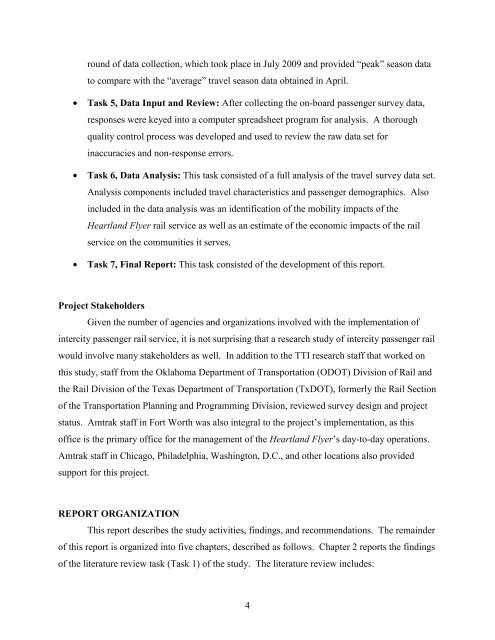Measuring the Benefits of Intercity Passenger Rail: A Study
Measuring the Benefits of Intercity Passenger Rail: A Study
Measuring the Benefits of Intercity Passenger Rail: A Study
You also want an ePaper? Increase the reach of your titles
YUMPU automatically turns print PDFs into web optimized ePapers that Google loves.
ound <strong>of</strong> data collection, which took place in July 2009 and provided “peak” season data<br />
to compare with <strong>the</strong> “average” travel season data obtained in April.<br />
• Task 5, Data Input and Review: After collecting <strong>the</strong> on-board passenger survey data,<br />
responses were keyed into a computer spreadsheet program for analysis. A thorough<br />
quality control process was developed and used to review <strong>the</strong> raw data set for<br />
inaccuracies and non-response errors.<br />
• Task 6, Data Analysis: This task consisted <strong>of</strong> a full analysis <strong>of</strong> <strong>the</strong> travel survey data set.<br />
Analysis components included travel characteristics and passenger demographics. Also<br />
included in <strong>the</strong> data analysis was an identification <strong>of</strong> <strong>the</strong> mobility impacts <strong>of</strong> <strong>the</strong><br />
Heartland Flyer rail service as well as an estimate <strong>of</strong> <strong>the</strong> economic impacts <strong>of</strong> <strong>the</strong> rail<br />
service on <strong>the</strong> communities it serves.<br />
• Task 7, Final Report: This task consisted <strong>of</strong> <strong>the</strong> development <strong>of</strong> this report.<br />
Project Stakeholders<br />
Given <strong>the</strong> number <strong>of</strong> agencies and organizations involved with <strong>the</strong> implementation <strong>of</strong><br />
intercity passenger rail service, it is not surprising that a research study <strong>of</strong> intercity passenger rail<br />
would involve many stakeholders as well. In addition to <strong>the</strong> TTI research staff that worked on<br />
this study, staff from <strong>the</strong> Oklahoma Department <strong>of</strong> Transportation (ODOT) Division <strong>of</strong> <strong>Rail</strong> and<br />
<strong>the</strong> <strong>Rail</strong> Division <strong>of</strong> <strong>the</strong> Texas Department <strong>of</strong> Transportation (TxDOT), formerly <strong>the</strong> <strong>Rail</strong> Section<br />
<strong>of</strong> <strong>the</strong> Transportation Planning and Programming Division, reviewed survey design and project<br />
status. Amtrak staff in Fort Worth was also integral to <strong>the</strong> project’s implementation, as this<br />
<strong>of</strong>fice is <strong>the</strong> primary <strong>of</strong>fice for <strong>the</strong> management <strong>of</strong> <strong>the</strong> Heartland Flyer’s day-to-day operations.<br />
Amtrak staff in Chicago, Philadelphia, Washington, D.C., and o<strong>the</strong>r locations also provided<br />
support for this project.<br />
REPORT ORGANIZATION<br />
This report describes <strong>the</strong> study activities, findings, and recommendations. The remainder<br />
<strong>of</strong> this report is organized into five chapters, described as follows. Chapter 2 reports <strong>the</strong> findings<br />
<strong>of</strong> <strong>the</strong> literature review task (Task 1) <strong>of</strong> <strong>the</strong> study. The literature review includes:<br />
4
















